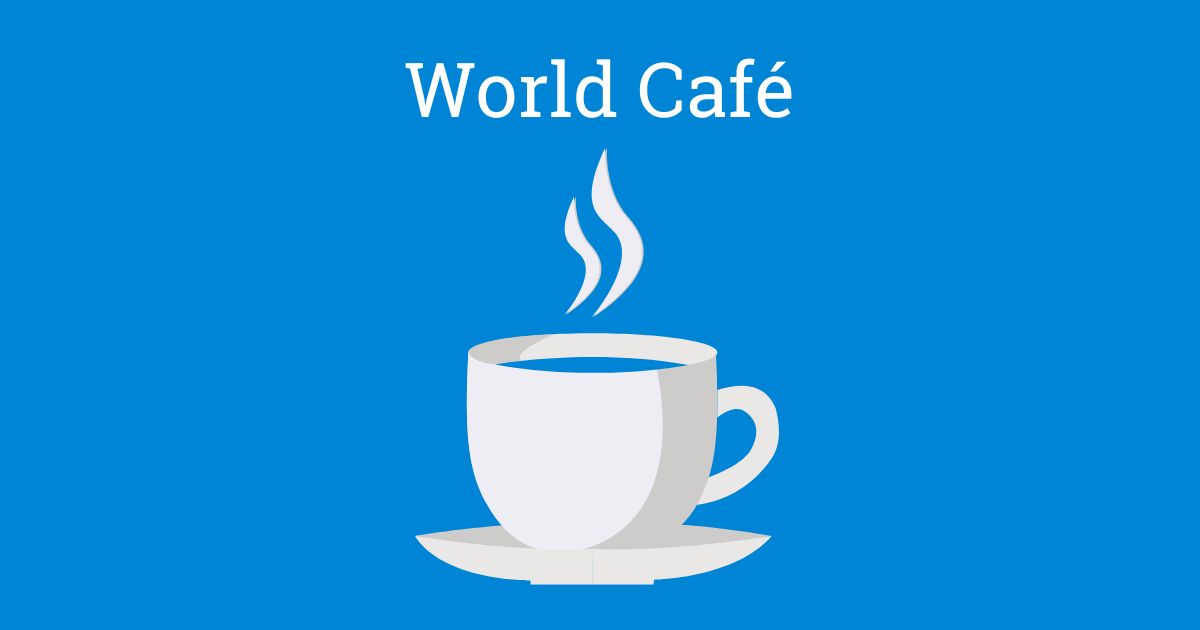The World Cafe Method is a collaborative way of engaging people in meaningful conversations about topics that matter to them. It’s a way to create a warm, friendly, and inviting atmosphere that encourages people to share their thoughts and experiences.
Participants are invited to sit at one of the tables and start a conversation with others who are already there. The conversation is focused on a specific topic or question that the group is interested in exploring.
After a set amount of time, everyone is invited to move to a new table and continue the conversation with a new person.
People constantly move around to have conversations with others to gain different perspectives and discover new ideas.
This process is repeated several times, with participants moving from table to table and building on the ideas and insights from previous conversations. At the end of the session, everyone comes together to share their key insights and ideas with the larger group.
Notes may be recorded in a variety of ways, such as:
- Paper tablecloths: participants are encouraged to write notes on paper tablecloths that are placed on top of each table. This allows for a care-free approach to note taking and doodling.
- Graphic recording: where notes are recorded centrally at the front of the room by a graphic facilitator or visual note-taker.
- Individual note-taking: encourage participants to take their own notes and share them at the end.
Pros of The World Café Method
- Promotes collaboration and active participation: The World Cafe method encourages people to work together and actively participate in discussions. It promotes a sense of collaboration and engagement, which can lead to more productive and meaningful conversations.
- Encourages creativity and diverse perspectives: By allowing participants to move around and discuss the topic from multiple angles, the World Cafe method can stimulate creativity and generate a wide range of perspectives.
- Builds a sense of community: The method can help build a sense of community among participants by creating an atmosphere of mutual respect and understanding.
- Allows for flexible group sizes: The World Cafe method can work well with both small and large groups, as the number of participants can be adjusted to suit the context.
Cons of The World Café Method
- May be time-consuming: The World Cafe method requires more time than other types of meetings or discussions, as participants move between different groups to share their ideas.
- May be difficult to manage: The method requires a skilled facilitator who can manage the different groups and ensure that the conversation remains focused on the topic at hand.
- May not work for all types of topics: The World Cafe method is better suited to open-ended, complex, and abstract topics, rather than more concrete or technical subjects.
- May not be suitable for introverted participants: The World Cafe method may not be ideal for individuals who are uncomfortable speaking up in group settings, as it places a strong emphasis on group discussion and interaction.
Tips for Facilitators
If you’re facilitating a World Café session shortly, here are some tips you can use:
1. Set the Tone
As the facilitator, it’s important to set a positive and welcoming tone for the World Café. Start with a warm welcome and introduction that helps to build a sense of community among the participants.
2. Provide Context
Providing context is a critical aspect of facilitating a World Cafe. When introducing the topic of discussion, it’s important to provide some background information that will help participants understand the issue at hand. This can include:
- Relevant facts and figures: Sharing statistics, research, or other data can help provide a clear picture of the problem or issue being discussed. This information can also be used to support or challenge different viewpoints.
- Historical or cultural context: It can be helpful to provide some historical or cultural context for the topic being discussed. This can help participants understand the roots of the issue and how it has evolved over time.
- Personal stories or experiences: Sharing personal stories or experiences related to the topic can help create a sense of connection among the participants and provide a more human perspective on the issue.
3. Define the Purpose
It’s important to clearly define the purpose of the World Café and communicate this to the participants. This will help to keep the conversation focused and productive.
4. Create a Comfortable Environment
Make sure that the space where the World Café is taking place is comfortable, with enough seating and adequate lighting. Consider using decorations or visuals to create a warm and inviting atmosphere.
5. Encourage Participation
The World Café method is all about active participation, so make sure to encourage all participants to share their thoughts and ideas. Ask open-ended questions and allow plenty of time for discussion and debate.
6. Use Visual Aids
Consider using visual aids like posters, charts, or sticky notes to help organize the conversation and make it easier for participants to track the discussion.
7. Facilitate Transitions
As participants move from one group to the next, it’s important to facilitate smooth transitions and make sure that everyone is on the same page. Use signals or announcements to let participants know when it’s time to move to the next group.
8. Summarize and Share Results
At the end of the World Cafe, take some time to summarize the key ideas and insights that emerged from the conversation. Share these results with the participants and consider publishing them in a report or online.


